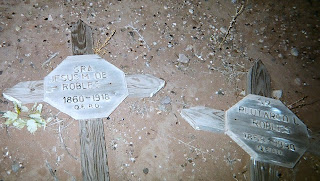Saturday, March 27, 2010
Chinese Section of the Globe Cemetery
Old Pirtleville Cemetery

Pirtleville's terrain is flat, harsh, hot and dusty. When the wind blows in the summer it sears your skin from the sheer heat. There are very few granite or marble headstones. If you see one it was placed by descendants of the deceased many years after their demise. Mostly, iron crosses and handwritten plaques commemorate those lying here. Cement frames may outline the grave. Cement and iron have weathered the elements. Wooden crosses and headstones have not fared so well. Most of them are in a seriously deteriorating state. But I love the wooden crosses because they are as natural an element of this environment as the heat and the wind. They seem to grow out of the very dirt they rise from.
This cemetery was featured in Ripley's Believe it or Not because of the custom of some choosing to be buried facing the South towards Mexico awaiting the Resurrection and return to their homeland. The wooden cross of Plutarco Robles above has the the common inscription, Q.E.P.D., "que en paz descanse" which translates, "rest in peace".
Subscribe to:
Posts (Atom)


